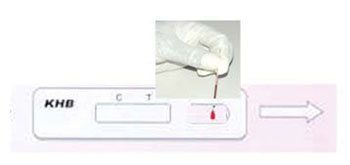Performing an HIV test using the KHB rapid test kit

First, collect the test items and other necessary laboratory supplies. Remove the KHB device from its packaging, and label it using a code number or a client identification number. The client is the patient or person taking the test. Code numbers should be used to ensure the test is anonymous.
The device has two parts — at the bottom there is a deep circular area where the blood sample is placed (the sample port); at the top there are two areas marked 'C' for control and 'T' for the test result line.
A photograph of a KHB test is shown in the above. The KHB, STAT-PAK and Uni-gold kits have similar structures and parts, though the Uni-gold kit has a different shape.
Collect the specimen using a capillary tube.
Add a drop of whole blood from the capillary tube, enough to cover the sample port of the device (this is shown in the figure below), before adding one drop of running buffer using a pipette. (A running buffer is a liquid that contains reagents and provides optimal conditions for the test to develop).

Now wait for 30 minutes for the test to develop. The control line will be the first to show, and this indicates that the test is working correctly and is valid.
Reading the result of a KHB test
After 30 minutes the test result is ready. Interpretation of the KHB test is straightforward, and examples of real test results are shown in the figure below.
If both the control line and test line are seen, the result is considered to be reactive (top panel, figure below). If only the control line appears and no test line is seen, the result is considered to be non-reactive (middle panel, figure below).
If the control line is not seen, the test has not worked correctly (it may have been damaged) and the result is considered to be invalid (bottom panel, figure below). If the result is invalid, the procedure is repeated using a new KHB device. The result must be recorded on a worksheet, together with any relevant information.

How would you interpret a non-reactive KHB result?
This indicates that the person who supplied the blood is HIV-negative and therefore there is no need to proceed to the STAT-PAK test.
What do you do if you get a reactive result using the KHB device?
If you get a reactive result with the KHB device, you should proceed to the second test, which is STAT-PAK, to confirm the result.